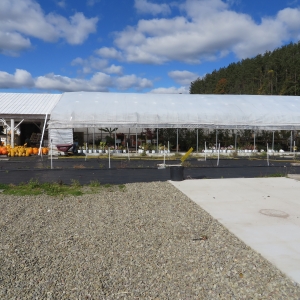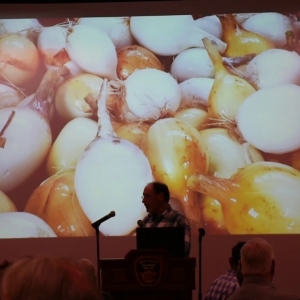Other Ag News:
(Washington, D.C., September 23, 2025) — Today, U.S. Secretary of Agriculture Brooke L. Rollins announced the USDA Forest Service is investing $200 million in 58 projects through the Community Wildfire Defense Grant Program. These investments, thanks to Congressionally mandated funding, help at-risk communities plan for and reduce wildfire risk, protecting homes, businesses, and infrastructure.
Washington, DC, September 23, 2025 – This week, over 500 hundred farmers from every state, US Territory, and several Tribal Nations delivered a letter to the United States Department of Agriculture (USDA) stressing the importance of the Sustainable Agriculture Research and Education Program (SARE). While SARE funding is normally made available in March, the RFA’s were not released this year until September 11, giving SARE Host Institutions little time to secure funding before the end of the fiscal year. The letter asks that USDA ensure SARE funding is delivered before the end of the fiscal year, to make certain farmers will be better prepared to meet future productivity challenges and remain competitive, due to more easily accessible and regionally appropriate research through SARE.
“As USDA’s only farmer-led research program, SARE has invested in farmer profitability, stewardship, and quality of life for over 35 years. At a time when farmers need more answers than questions, SARE’s stellar, decades-long track record proves it can offer exactly that,” said Mike Lavender, Policy Director at the National Sustainable Agriculture Coalition.
“The current demand for sustainable agriculture solutions far outweighs available resources. SARE plays a critical role in helping farmer driven research keep pace with the growing challenges related to the state of the rural economy, soil health, and competitiveness of American producers. NSAC remains a strong supporter of SARE and continues to advocate for growing the program’s research and funding capacity,” said Nick Rossi, Policy Specialist at the National Sustainable Agriculture Coalition.
Since 1988, the Sustainable Agriculture Research and Education Program (SARE), has funded more than 9,000 farmer-driven research and education initiatives through competitive grant awards totaling nearly $478 million. As the only farmer-driven, sustainable agriculture competitive research grant program offered by the USDA, SARE provides farmers and researchers with vital opportunities to better understand agricultural systems and to increase profitability, build on farm resilience, and strengthen rural communities.
Find the letter here.
Read what farmers are saying about their involvement with SARE:
“I received a SARE grant to help the Kansas City Food Hub – a Cooperative owned by 15 farmers (including myself- we are now owned by 30 farmers) about six years ago when the Hub had been in business for 4 years and had outgrown systems that were under strain from increased sales. Our project aimed to upgrade our food safety system and develop a new brand for the business. Our upgraded food safety protocols helped us bring on a new big institutional client. When COVID hit and that institution closed, because of our new branding and website, the public was able to find us easily and we were able to pivot our sales from 100% wholesale to 100% retail,” said Katie Nixon of Green Gate Family Farm, Missouri.
“I received a Farmer/Rancher grant in the late 1990’s. I served on the NC Region SARE advisory committee for 8 years. I still serve on the Kansas advisory committee.I have seen firsthand how frugally SARE’s implementation structure operates. This program is 37 years old, and is very well respected throughout rural America. It would have been such a crime to see it eliminated. Thankfully, common sense prevailed” said Donn Teske, a sixth generation beef cow/calf rancher, Kansas.
“SARE helps growers like me do practical, on-farm research that is specific to my climate. Right now, precious little research is done on semi-arid, small-scale vegetable growing, so another farmer and I are doing the research ourselves through a SARE grant. The emphasis of SARE on the E (education) means that this research doesn’t go on a shelf somewhere–it goes directly from farmers to farmers who can use it now... If USDA cuts this small but mighty program, it will be another confirmation that the government is only interested in corporate export agriculture, not local family farms like mine. It shows a real lack of understanding of food access and security and who really feeds people in America,” said Nella Mae Parks of Nella Mae’s Farm, Oregon.
“As a farmer, I value the SARE program because it provides crucial funding for research that helps us develop farming practices that protect our soil and water while still maintaining profitable operations. Because so much research is carried out by researchers without a farmer’s perspective, the program’s focus on farmer-to-farmer education means we’re learning practical solutions from other producers who understand the real challenges we face in the field every day. SARE’s support for on-farm research projects allows us to test sustainable methods on our own land in real world scenarios and share those results, creating a community of farmers working together to build markets, techniques, and know-how that leads to a more resilient agricultural industry,” said Bill Pluecker of Begin Again Farm, Maine.
“I am still glowing from taking big steps on my SARE project yesterday. We signed an agreement with another farmer and that farmer accidentally “caught lightning in a bottle” on part of their farm. Our SARE project is partially about replicating their success. By sheer coincidence, their crops spontaneously did something extraordinary. We are working to replicate what happened, so that other farmers can benefit... I was in the field with some other chestnut farmers. The land use history of that place is unusual- a coal company cleared the forested land, an oak and American chestnuts- and then changed their mind about mining that spot, so they planted Chinese chestnuts, before deciding to sell the land. Because of this, something weird happened. A section of this Chinese chestnut orchard has North American species of Boletus variipes mushroom growing under Chinese chestnuts. Maybe the mushroom survived in the soil for a few years, from the forest trees that used to grow there. The combination of an American porcini and a Chinese chestnut is unknown. We were hoping to find this pairing, however, because our goal is to produce Boletus mushrooms to sell on the global porcini market. We didn’t want to introduce an Asian or European species of mushroom to our chestnut orchard, because we didn’t want to accidentally unleash a new invasive species. Now that we’ve found a native species, we think we can help Chinese chestnut trees produce a type of expensive, nutrient-dense mushrooms for sale- much like farmers in Europe and Asia have been doing for centuries!” said Badger Johnson of Paradise Ecological Services, Ohio.
###
About the National Sustainable Agriculture Coalition (NSAC):
The National Sustainable Agriculture Coalition is a grassroots alliance that advocates for federal policy reform supporting the long-term social, economic, and environmental sustainability of agriculture, natural resources, and rural communities. Learn more: https://sustainableagriculture.net/
The post Release: Over 500 Farmers Rally Behind the Sustainable Agriculture Research and Education Program appeared first on National Sustainable Agriculture Coalition.
For Immediate Release
Contact: Laura Zaks
National Sustainable Agriculture Coalition
press@sustainableagriculture.net
Release: Nearly 600 Groups Deliver Joint Letter to Congress Urging a Strong and Fair Farm BillWashington, DC, September 22, 2025 – Today, the National Sustainable Agriculture Coalition (NSAC) and nearly 600 national, state, and local organizations delivered a joint letter to Congressional leaders urging them to aim high toward a farm bill that invests in our mutual prosperity. Addressed to Senate and House leadership as well as Agriculture Committee chairs and ranking members, the letter calls on Congress to address the harmful provisions enacted through the recently passed budget reconciliation bill (P.L. 119-21). Against the backdrop of a dire farm economy, the letter calls for advancing a long overdue farm bill that supports family farmers, rural communities, healthy food access, essential nutrition programs, and more.
“The decisions made in this farm bill will touch every person in this country,” the letter states, “[we] stand together to say we will only support a farm bill that provides adequate and accessible SNAP benefits to families and individuals; makes our food safer, healthier, and more affordable; supports good, family-sustaining jobs for food workers; supports family farmers and their communities; and ensures our food is produced in ways that are consistent with our values.”
The diverse coalition of signatories includes organizations focused on addressing hunger and nutrition, labor, farm, rural communities, and sustainability. Nearly 80 national organizations joined more than 500 state and local organizations from every region of the country including insular areas.
“As organizations representing millions of individuals, farmers, workers, and families whose lives and livelihoods are impacted by the farm bill, we urge you to aim high toward a farm bill that restores Americans’ trust in the federal government. … A good farm bill would fully address the devastating and ongoing impacts of the U.S. Department of Agriculture’s office closures, reorganizations, relocations, as well as the uncertainty exacerbated by funding freezes, award terminations, and staff firings – all of which have weakened the Department’s ability to serve farmers, rural small businesses, and food insecure communities… Anything short of that fails our farmers, our communities, and us all.”
Read the full letter here.
###
About the National Sustainable Agriculture Coalition (NSAC)
The National Sustainable Agriculture Coalition is a grassroots alliance that advocates for federal policy reform supporting the long-term social, economic, and environmental sustainability of agriculture, natural resources, and rural communities. Learn more and get involved at: https://sustainableagriculture.net
The post Release: Nearly 600 Groups Deliver Joint Letter to Congress Urging a Strong and Fair Farm Bill appeared first on National Sustainable Agriculture Coalition.
(Washington, D.C., September 21, 2025) – Hours ago, Mexico’s National Service of Agro-Alimentary Health, Safety, and Quality (SENASICA) confirmed a new case of New World screwworm (NWS) in Sabinas Hidalgo, located in the state of Nuevo León, less than 70 miles from the U.S.-Mexico border.
(Washington, D.C., September 20, 2025) — The U.S. Department of Agriculture announced the termination of future Household Food Security Reports. These redundant, costly, politicized, and extraneous studies do nothing more than fear monger.
(Washington, D.C., September 19, 2025) – U.S. Secretary of Agriculture Brooke L. Rollins today announced the latest slate of presidential appointments and state directors for key positions at the U.S. Department of Agriculture (USDA).
(Washington, D.C., September 18, 2025) – U.S. Secretary of Agriculture Brooke L. Rollins and U.S. Secretary of Commerce Howard Lutnick jointly published an opinion piece in the Anchorage Daily News highlighting the new America First seafood strategy in Alaska.
Washington, DC, September 17, 2025 – This week, Representatives Marilyn Strickland (D-WA-10), Alma Adams (D-NC-12), and Senator Peter Welch (D-VT) reintroduced the Capital for Beginning Farmers and Ranchers Act in the House and the Senate.
The Capital for Beginning Farmers and Ranchers Act directs the Farm Service Agency (FSA) to develop a multi-year operating loan pilot for beginning farmers to finance initial assets and the development of production and management systems. These expenditures can include intangible business infrastructure for crop records, payroll, and regulatory compliance, investments to increase soil fertility, and more.
“The Capital for Beginning Farmers and Ranchers Act provides necessary support for the next generation of farmers and ranchers, who face high-start up costs and too often struggle to repay loans within their first year of operation. This practical and balanced pilot program would alleviate challenges with limited access to more flexible capital, and open opportunities to invest in key start-up capacities that will benefit their farm for years to come,” said Duncan Orlander, Policy Specialist at the National Sustainable Agriculture Coalition. ”
Specifically, the terms of the Beginning Farmer and Rancher Development Loan Pilot Program authorized in the Act would include:
- Direct and guaranteed FSA loans with a repayment term between 3 and 10 years;
- A loan limit of $100,000 for both direct and guaranteed development loans;
- Reduced collateral requirements of not greater than 100% loan-to-value;
- Reduced interest rate between zero and 3%, as determined by the Secretary;
- Flexible principal repayment as determined by FSA, but not less than 1% of the remaining balance annually;
- Robust technical assistance for development loan borrowers; and
- Evaluation and reporting that measure pilot program success.
###
About the National Sustainable Agriculture Coalition (NSAC)The National Sustainable Agriculture Coalition is a grassroots alliance that advocates for federal policy reform supporting the long-term social, economic, and environmental sustainability of agriculture, natural resources, and rural communities. Learn more: https://sustainableagriculture.net/
The post Release: NSAC Welcomes the Reintroduction of the Bicameral Capital for Beginning Farmers and Ranchers Act appeared first on National Sustainable Agriculture Coalition.
When Congress returned from its August recess, it faced a long to-do list and little time to act.
On the September list is to fund the government by September 30, when current funding expires for the US Department of Agriculture (USDA) and across the federal government. A failure to fund the government by September 30 would result in a government shutdown, significantly impacting USDA’s ability to serve farmers, ranchers, and stakeholders nationwide.
Meanwhile, Congress is now nearly 7 years removed from passing a full farm bill. Earlier this year, President Trump signed the so-called One Big Beautiful Bill Act (OBBB, P.L. 119-21) into law, which slashed SNAP benefits by nearly $186 billion and directly reinvested more than $50 billion of that to further increase farm subsidies to the largest, wealthiest farmers, while programs that support the vast majority of farmers and rural communities were excluded from the bill entirely. The inclusion of a handful of traditional farm bill programs in budget reconciliation has severely diminished the likelihood that Congress will pass a comprehensive and fair farm bill this year, or at all this Congress.
With all this in mind, this blog post analyzes fiscal year (FY) 2026 agriculture appropriations proposals in both the House and Senate, the prospects of a government shutdown at the end of September, and whether a farm bill may move later this year.
FY2026 Agriculture AppropriationsOn June 23, 2025, the House Appropriations Committee approved – in a 35-27 party-line vote – its fiscal year (FY) 2026 Agriculture, Rural Development, Food and Drug Administration, and Related Agencies Appropriations Act. Meanwhile, on August 1, 2025 the full Senate passed its version of the FY2026 Agriculture Appropriations bill with strong bipartisan support, 87-9.
At a high level, the Senate bill sets FY26 Agriculture spending at just over $27 billion and maintains level funding for numerous NSAC priorities. Meanwhile, the House bill sets FY26 Agriculture spending at $25.5 billion, reducing funding for critical programs that serve farmers and their communities. The House bill also includes harmful policy riders that would prevent implementation of three rules designed to promote fair competition for livestock farmers under the Packers and Stockyards Act, as well as any similar rulemaking effort (Section 729), and prevents any funding for efforts related to Executive Order 13985, which seeks to advance racial equity and support for underserved communities through the USDA (Sec. 755).
Both the Senate and House bills include language relevant to the proposed USDA reorganization. In Sec. 746 of the House bill and Sec. 750 of the Senate bill, the following language appears:
Notwithstanding any other provision of law, no funds available to the Department of Agriculture may be used to move any staff office or any agency from the mission area in which it was located on August 1, 2018, to any other mission area or office within the Department in the absence of the enactment of specific legislation affirming such move.
Separately, during the full Senate’s consideration of its bill, Senators voted on an amendment led by Senator Chris Van Hollen (D-MD) that would have prevented the reorganization until USDA had: collected public input from stakeholders on the reorganization; conducted and made public a benefit-cost analysis; and required a report on how USDA would maintain staff expertise throughout the reorganization. While many members of Congress have spoken out with concerns about the USDA reorganization, the amendment ultimately failed 42-53 along party lines, with the exception of two Senators from Colorado joining all Republicans in opposing the amendment.
Conservation, Energy and EnvironmentOne of the most notable areas where the House and Senate FY26 appropriations bills diverge in funding is for Conservation Technical Assistance. In the Senate, the Natural Resources Conservation Service (NRCS) Conservation Operations account – 85% of which funds NRCS staff capacity and partnerships with third party conservation organizations through the Conservation Technical Assistance (CTA) program – comes in at $895.75 million. The bill reserves $775.495 million of the Conservation Operations funding for CTA. Conservation Operations saw a $26 million cut in overall funding from FY23 to FY24, and the proposed FY25 Senate funding level would bring Conservation Operations funding well above its FY23 levels, but still well below the $1.2 billion that NSAC and dozens of other conservation organizations requested.
The Senate bill reserves $10 million from the CTA funding pool for the Grazing Lands Conservation Initiative (GLCI), maintaining its current funding level. GLCI – which promotes high quality livestock grazing techniques – was funded at $10 million in FY2024 and FY2025. The Senate’s number of $10 million is an important counter to the House proposal, which has zeroed-out funding for GLCI the past several fiscal years, and NSAC is thrilled to see support for such a valuable program. We hope that continued leadership in the Senate can lead to a restoration of GLCI funding in future years to its historic levels of nearly $30 million.
The House bill, on the other hand, funds Conservation Operations at $850 million, more than $45 million below both current funding levels and the Senate proposal. It also rescinds an additional $50 million of unspent funding allocated in previous fiscal years through a rider (Sec. 765). Funding for CTA in the House bill is $705 million, a nearly $70 million cut from current funding levels, showing that the majority of funding cuts by House appropriators for Conservation Operations are directed at CTA. As noted above, the House continues to attempt to zero out funding for GLCI in FY25, despite the growing popularity of grass-based systems among new farmers and ranchers.
Research and OrganicsThe House and Senate bills do not differ significantly on sustainable and organic research, though there are noticeable differences in the report language accompanying the bills, including the Senate’s emphasis on the important role sustainable and organic research programs play in building agricultural resilience.
The Sustainable Agriculture Research and Education Program (SARE) receives $48 million in funding in the Senate’s proposal, level with FY24’s enacted level but still below SARE’s funding of $50 million in FY23. While NSAC is pleased to see no further funding cuts to SARE in the Senate proposal, we are disappointed that the Senate bill did not restore SARE’s funding to FY23 levels. The failure to restore SARE’s funding has a compounding impact as applicants continue to be turned away from the program for lack of sufficient funding.
SARE provides farmers and researchers with vital opportunities to better understand agricultural systems and increase profitability.The current demand for sustainable agriculture solutions far outweighs available resources. According to SARE’s most recent 2023-2024 Biennial Report From the Field, less than 40% of Farmer Rancher Grant proposals were able to receive funding between 2022-2023. The Committee also included report language on SARE regarding its important work on soil health:
“The Committee appreciates the work SARE has done to improve soil health through cutting edge research, education, and extension on cover crops, diversified rotations, and managed grazing. The Committee expects the funding provided to be focused on increasing agricultural resilience, including, where appropriate, interdisciplinary systems research and education, farmer and rancher research and demonstration grants, and graduate student research grants.”
Elsewhere within the purview of USDA’s Research, Education, and Economics (REE) Mission Area, a number of priorities important to NSAC members received level funding in the Senate bill. The Organic Agriculture Research and Extension Initiative (OREI) did not receive any discretionary funding on top of its mandatory authorization level of $50 million, continuing a trend in recent years. The Organic Transitions Program (ORG) received level funding of $7.5 million. The Committee included report language highlighting the importance of organic research and the need for more organic research across USDA REE.
“Organic Research.—USDA’s National Organic Standards Board [NOSB] has identified key organic research priorities, many of which would help to address challenges that have limited the growth in organic production in this country. The Committee encourages NIFA to give strong consideration to the NOSB organic research priorities when crafting the fiscal year 2026 Request for Applications for AFRI and the Organic Transition Program. Given the growing demand for organic products, the Committee also encourages USDA to increase the number of organic research projects funded under AFRI and the Specialty Crop Research Initiative.”
The Senate bill does not provide any additional discretionary funding for the Farming Opportunities Training and Outreach Grant Program (FOTO), which includes both the Beginning Farmer and Rancher Development Program and Outreach and Assistance for Socially Disadvantaged Farmers and Ranchers (Sec. 2501). While FOTO receives $50 million in mandatory funding that is unaffected by annual appropriations, the program has also received additional discretionary appropriations each year between FY20 – FY23, which NSAC members have strongly supported.
As opposed to the Senate’s approach to mostly level-fund key sustainable and organic research and education programs, NSAC is disappointed to see SARE receive $40 million in funding through the House proposal, an $8 million cut to FY24’s enacted level. Over the past several years the House has continuously worked to cut funding for SARE, despite the program’s wide popularity among farmers and ranchers. In House Agriculture Appropriations Subcommittee Chairman Andy Harris’ (R-MD-1) home state of Maryland alone, over 7,000 farmers have participated in SARE since 2020.
Similar to past years, the House bill attempts to remove funding for USDA’s Climate Hubs. The House bill also treats OREI and ORG the same as the Senate, and includes some report language recognizing the value of organic research:
“Organic Agriculture Research.—The Committee encourages NIFA to consider the USDA National Organic Standards Board organic research priorities when crafting future AFRI Requests for Applications. Given the growing demand for organic products, the Committee also encourages NIFA to continue organic research projects funded under AFRI.
Similar to the Senate, the House bill does not provide any additional funding for FOTO.
Local and Regional Food SystemsThe Senate and the House continue to prioritize funding for local and regional food systems at different levels.
The Local Agriculture Market Program (LAMP), created in the 2018 Farm Bill, is USDA’s primary funding source for local and regional food system initiatives across the country. LAMP is a combination of the Value-Added Producer Grant Program (VAPG), the Farmers Market and Local Food Promotion Program (FMLFPP), and the Regional Food System Partnership Program. Combined, they invest in processing, distribution, and marketing of local foods.
The Senate and the House have consistently funded FMLFPP; both provide the maximum authorization of $7.4 million to be split between the two programs, which is level funding from FY25. While the Senate maintains strong support for producer grants, authorizing $11.5 million for VAPG, the House proposes a significantly lower level of $5 million. The House’s sizable proposed cut in funding for the program is a new trend; they proposed the same in FY25. A decrease in funding for VAPG would have a greater impact this year compared to previous due to the increase in popularity of the program. Earlier this year, VAPG implemented a new grant application process that seeks to remove barriers for producer applicants. It is demonstrating initial success; Rural Development staff shared that the number of applicants nearly doubled.
The Office of Urban Agriculture and Innovative Production (OUAIP) is another impactful program addressing community food security through local producer networks in urban, suburban, and rural communities. Since OUAIP received its first appropriation in 2020, it has invested over $85 million in 199 grants and 146 cooperative agreements to increase the capacity of agricultural production and municipal composting initiatives in local communities across 43 states and Puerto Rico. Yet, the office remains unable to meet its full potential due to Congress continuously underfunding it. While authorized at $25 million annually, the Senate includes only $6 million – a decrease from $7M in FY25; and an even greater decrease from $8.5 in FY23. The House includes $4 million, as a result of Congressman Mark Alford (R-MO-4) including an amendment during markup, after initially being completely left out of the bill with zero funding. These levels are simply insufficient to meet program demand. We recommend significant increases to fund more than 14% of projects – the cumulative award average as of last year.
Government ShutdownDespite a decent amount of progress – albeit behind schedule – on FY2026 agriculture appropriations, there nevertheless remains a significant possibility of a government shutdown beginning October 1, 2025.
Negotiations on government funding beyond September 30 are developing by the minute and as of posting this blog, it appears possible – though not certain – that the federal government will shutdown for an undetermined period of time beginning October 1. So what, exactly, would a government shutdown mean for agriculture?
Capitol building in the fall. Photo credit: NSACEach agency and department throughout the federal government, including USDA, is required to develop a government shutdown contingency plan, available here.
While USDA will need to keep a number of employees working to handle critical functions, non-essential programs will be forced to a halt. In the past, essential activities have included but were not limited to: food safety inspections, wildfire suppression, nutrition assistance programs, and monitoring imports for pests and diseases. The number of employees that will be furloughed will depend on how long the shutdown lasts.
In particular, we anticipate that a shutdown would adversely impact farmers and ranchers who rely on county-level USDA offices of the Farm Service Agency and the Natural Resources Conservation Service. These local offices – many of which are already strapped due to the ongoing USDA staffing crisis – would close, and while the impact from the closures may not be felt immediately, the longer the shutdown runs, the more acutely farmers and stakeholders will feel the impact.
Farm BillAs many of our readers will know, Congress has not passed a full farm bill since December 2018. While OBBB – which was signed into law in July 2025 – included some components of a traditional full farm bill, it excluded many programs that support the vast majority of farmers and rural communities. This calculated move effectively ended a decades-long era in which federal farm bills were passed by coupling nutrition assistance and farm programs, raising legitimate questions of how, or even whether, future farm bills might pass Congress.
House Agriculture Committee Chairman Glenn “G.T.” Thompson (R-PA-15) has indicated that he would like the House to approve a farm bill this fall, yet there is no clear path to accomplish that goal in the House of Representatives let alone Congress as a whole, nor has there been concrete evidence of a timeline or commitment to enacting a bipartisan farm bill anytime soon. On the other side of the US Capitol, there has yet been no indication that the Senate has the capacity or appetite to advance a new farm bill this fall.
Even amidst this uncertainty, some truths remain constant. Congress must pass an extension of the 2018 Farm Bill by September 30, 2025 or December 31, 2025 at the very latest, in order to prevent critical programs’ lapsing authorization. More broadly, for a farm bill to become law this year, it must meet the high bar of a good farm bill. The bill should move our food and farm system forward by meaningfully supporting family farmers and their communities while addressing OBBB’s impact on families and individuals.
The post September in Washington, DC: FY26 Appropriations, Shutdown, and Farm Bill appeared first on National Sustainable Agriculture Coalition.
On July 24, 2025, Secretary Rollins released a memo (SM-1078-015) describing the planned reorganization of the U.S. Department of Agriculture (USDA) staff, drafted without any consultation with farmers or other stakeholders. USDA has already lost more than 20,000 staff since January 2025 and if the reorganization moves forward as planned, it will result in the likely loss of thousands more staff. This is the second post in a series discussing the loss of USDA staff since January 2025 and the expected impacts of the proposed USDA reorganization across issue areas. This post examines staffing losses and planned cuts across the research agencies at USDA and their devastating impacts on agricultural research and innovation. Our previous post describes the staffing losses across the USDA and states.
USDA’s research agencies – the National Agricultural Statistical Service (NASS), Economic Research Service (ERS), Agricultural Research Service (ARS), and National Institute of Food and Agriculture (NIFA) – have been hit particularly hard by recent staff losses and have significant cuts planned in the reorganization. These research staff and sites provide the human capital and infrastructure for agricultural research as well as data collection and analysis for commodities and rural communities. Unfortunately, recent history has shown that staff losses in these agencies leads directly to reduced productivity and support for stakeholders. In this post, we examine the toll of staffing declines and proposed cutbacks in USDA research agencies, and what they mean for the future of agricultural knowledge and innovation.
After widespread concerns about the proposed reorganization, USDA opened an adhoc public comment opportunity. The National Sustainable Agriculture Coalition (NSAC) encourages organizations and individuals to submit their comments, questions, and concerns regarding the reorganization to USDA at reorganization@usda.gov by September 30, 2025. NSAC remains concerned about the lack of transparency involved in this comment period, given that the opportunity for public comment has not been formally provided through the Federal Register, as is standard practice for proposals of this scope.
Research Staff Have Been GuttedThe four major research agencies of USDA have already lost approximately 23% of their staff since January 2025. 1,600 employees left the research agencies through DOGE’s Deferred Resignation Program (DRP). DRP offered federal employees fully paid administrative leave through September 2025 if employees voluntarily resigned their positions. 351 research agency staff accepted the DRP in the first round beginning in January 2025 and an additional 1,249 research staff accepted the second round of DRP in April 2025.
Figure 1: Research Staff Losses
According to the Office of Personnel Management (OPM), approximately 370 additional staff separated from the research agencies between January and March 2025. Separations include staff who retired (voluntary, early, or for disability), quit, had their contracts expired or terminated, were fired, transferred to a different agency, or otherwise separated from employment.
Table 1: Research Staff Losses by Agency
NASS, the internal statistical branch of the USDA, has lost the highest percentage of staff since January 2025 among research agencies, losing approximately 30% of their staff to DRP and 4% additional staff who separated from the agency. NASS collects hundreds of surveys on agriculture and food and prepares a wide range of reports on virtually every component of American agriculture. They administer the Census of Agriculture every five years, the only dataset that provides information on every American county and farm over time. They also collect and analyze data on every commodity and market in American agriculture. NASS provides essential unbiased data on US agriculture that undergirds farmers’ decisions and the decisions of policymakers.
ARS, the internal in-house scientific research agency of the USDA, has lost the largest number of employees since January 2025 among research agencies. ARS lost 1,225 employees to DRP and an additional 298 staff who separated from the agency between January and March 2025. ARS’s mission is to “deliver scientific solutions to national and global agricultural challenges” and they employ a wide range of scientists and staff at a network of research sites throughout the country, often in partnership with universities and private sector companies. The loss of ARS staff undermines the ability of the agency to fulfill its mission and provide the research needed by American farmers and ranchers. ARS researchers, in particular, are highly specialized scientists with skills that are very difficult to replace.
The loss of ARS scientists means that several research projects vital to the resilience of American agriculture have already stopped. In an interview with Wyoming Public Radio, two former ARS researchers talked about the losses caused by the loss of staff such as themselves. According to one scientist: “I worked directly with a lot of farmers, visiting farms, going to meetings of farmers, and making sure that they had the most up-to-date research to inform their management decisions. Also listening to what challenges they were facing, and making sure that those challenges were being reflected in the research that the Agricultural Research Service was doing [and] bringing those concerns back to the researchers.” The scientist further shared: “All my projects revolved around helping smaller farmers deal with the impacts of drought in this region and all of those projects have been cancelled.”
The nearly 2,000 employees lost from USDA research agencies directly hinder the ability of the department to fulfill its mission to “advance scientific knowledge related to agriculture.” These staffing losses and administrative setbacks have already led to significant disruptions including delaying or deferring several NIFA research programs for fiscal year 2025. The Foundational and Applied Science Program, for example, was delayed so significantly that the fiscal year 2025 program was skipped altogether and the request for applications is now for fiscal year 2026.
The Reorganization Will Further Degrade Research AgenciesUSDA research agencies are already experiencing significant losses in their ability to serve stakeholders and the planned reorganization will cause further damage.
ARS is hit particularly hard by the planned reorganization. The reorganization includes a plan to close the Beltsville Agricultural Research Center (BARC), located in Beltsville, Maryland. BARC has operated since 1910. Comprising approximately 6,000 acres of agricultural research fields and facilities, BARC is the largest ARS research facility and hosts research on food animal production, animal health, entomology, food safety, water management, soil quality, air quality, rangeland systems, sustainable agriculture, plant genetics, plant diseases, crop protection, crop production and virtually every aspect of agricultural production systems.
BARC has produced impactful research for over a century, benefiting American farmers and agriculture. For example, BARC researchers developed and licensed a patented antibody designed for wide-spectrum identification of potyviruses, a major group of plant viruses with high economic impact. These anti-viral technologies are now widely developed and sold by Agdia to detect and prevent potyviruses in a variety of crops such as beans, potatoes, and industrial hemp and prevent billions in lost productivity every year.
Photo by Kaitlan Balsam on UnsplashClosing and relocating the Beltsville facility will be extremely difficult and costly and will cause unavoidable damage to research productivity. Long-term field studies are particularly important to agricultural research to understand the long-term functioning of agricultural systems such as soil health and pest burden. The long-term field research at Beltsville cannot simply be relocated, and losing these field sites means losing irreplaceable scientific knowledge. Relocating facilities such as the Electron and Confocal Microscopy Unit (ECMU) would be extremely difficult and expensive, if possible at all. While the USDA reorganization plans to close and relocate BARC over several years to minimize research disruptions, experts are highly doubtful that the closure would be able to do so or would generate any cost savings.
Despite claiming to want to move the Department closer to farmers, the reorganization also calls for the closure of ARS Area Offices. ARS is currently divided into five geographic areas: Northeast, Southeast, Midwest, Plains, and Pacific West. Each area has an Area Office that oversees the facilities and staff in that region, ensuring that the research addresses regionally significant topics and problems. Closing Area Offices would undermine the ability to prioritize regional issues and weaken connections to farmers and stakeholders in the region. It would also mean administrative processes such as hiring and facilities management would be funneled through a single national office, creating delays and inefficiencies and would undermine the important regional partnerships and networks with collaborators such as land-grant universities. Closing ARS Area Offices will not “streamline” services, it will weaken local accountability and slow down work.
Likewise, the reorganization calls for the closure of NASS regional field offices to be replaced with offices in five new USDA hubs. NASS has twelve regional field offices in the country, each responsible for the statistical work in that region. These field offices oversee the data collection and management in the states of their region and provide the data and statistics for those states. The field offices are essential to maintaining stakeholder relationships and making sure that farmers and ranchers in every state and region are adequately represented in national statistics. Consolidating NASS offices to the newly proposed hubs in Raleigh, North Carolina; Kansas City, Missouri; Indianapolis, Indiana; Fort Collins, Colorado; and Salt Lake City, Utah would leave large swaths of the country unrepresented. Farmers and ranchers in the Northeast and West Coast, in particular, would have inadequate representation to ensure they are adequately included in agricultural statistics.
NASS regional offices are essential to improving farmers’ trust of the agency and to boosting survey response rates from farmers. Ensuring every farmer is counted in national statistics is essential and regional offices are vital to that effort.
The Deterioration Continues: Staff Losses at ERS and NIFA Since 2019 RelocationsDespite significant public outcry, ERS and NIFA were relocated to Kansas City, Missouri in 2019 during the previous Trump Administration. ERS provides research on economics and agriculture, producing research on future commodity price projections, farm income, and essentially all aspects of American agriculture and rural communities. The economic reports and research generated by ERS are used by farmers, policymakers, and other stakeholders as they make major decisions for the agricultural economy such as changes to commodity programs or loans. NIFA oversees the department’s competitive grant programs, investing in research, education, and extension programs for American agriculture. NIFA funds universities and other partners to advance agricultural science, innovation, and education nationwide.
This relocation of ERS and NIFA led to hard-learned lessons concerning how destructive relocations can be. According to the Government Accountability Office (GAO), these staff losses reduced the number of reports and articles generated by ERS staff in half and led to the loss or delay of several vital industry reports. The loss of these publications and reports meant that farmers and other stakeholders had to make risky decisions with less information. Within NIFA, the relocation led to delays and suspensions of several grant programs and payments. For example, land grant universities across the country struggled as NIFA’s Capacity Grants that support basic research facilities were delayed by more than a fiscal quarter, undermining the research and services of those universities. When NIFA grants are delayed or suspended, vital research is threatened and American farmers and the agricultural sector suffer.
It has taken years for ERS and NIFA to rebuild their capacity following the relocation and attempt to replace the lost institutional knowledge needed to serve American agriculture and stakeholders. But both agencies are again being decimated by staff losses. ERS has lost 27% of their staff to DRP and an additional 2% to other separations. NIFA has also experienced widespread staffing losses since January 2025. NIFA lost 11% of their staff to DRP and an additional 8% to other separations. These staffing losses have already led to delayed and deferred grant programs and will, we can infer based on recent history, lead to further losses in research productivity and delays that undermine American agriculture.
USDA’s Research, Education, and Economics mission area that houses ARS, ERS, NASS, and NIFA is tasked with providing reliable scientific research, data, and analysis for America’s farmers, ranchers, rural communities, and stakeholders. The staff in these agencies are highly skilled and specialized workers who are dedicated to public service. Each of the four agencies have already lost overwhelming numbers of staff and the planned USDA reorganization will further compromise their ability to fulfill their missions.
The post USDA Staffing Crisis: Research Agencies Face Steep Losses as Reorganization Advances appeared first on National Sustainable Agriculture Coalition.
Pages
Signup for the Ag Newsletter
Get the freshest farm news, events and updates from in and around Cattaraugus County, NY at least once a month! Go signup!
Other ways to stay connected:
Get Involved in Farming
Resources for Starting a Farm in Cattaraugus County
Profile of Cattaraugus County soils
Agriculture Career Exploration
Questions about farming? Find out Who to Call











